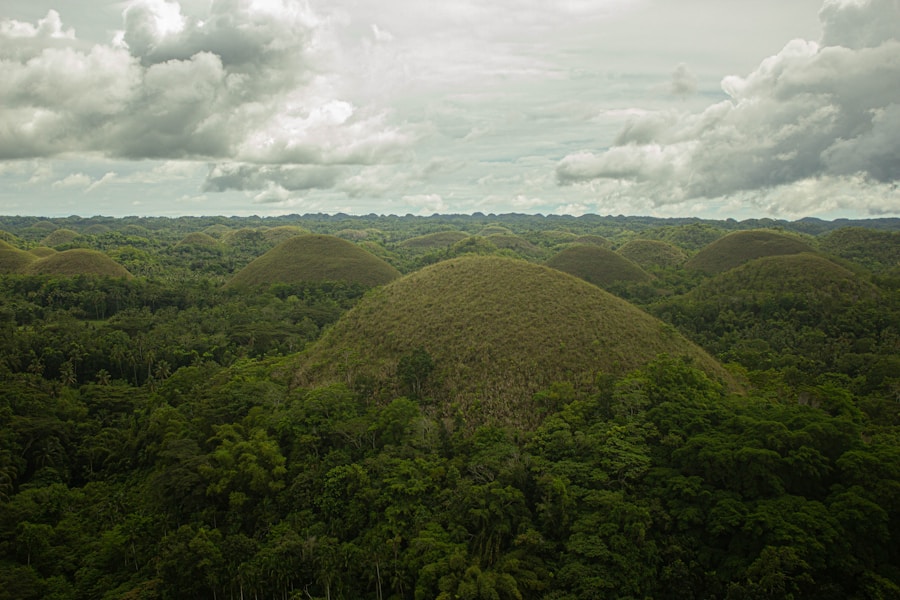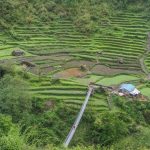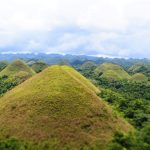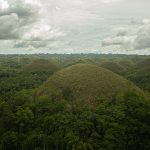Discovering the Mysterious Chocolate Hills
Description
The Chocolate Hills, a geological wonder located in the Bohol province of the Philippines, have captivated visitors with their unique and striking appearance. These hills, numbering over 1,200, rise dramatically from the surrounding landscape, creating a surreal panorama that has sparked curiosity and intrigue for centuries. The origin of these hills is rooted in a combination of geological processes that date back millions of years.
The prevailing theory suggests that they were formed through the uplift of coral deposits and limestone, shaped by the forces of erosion and weathering over time. This process began during the Pleistocene epoch when the region was submerged under the sea, allowing marine organisms to deposit calcium carbonate, which eventually solidified into limestone. As tectonic activity raised the land above sea level, the limestone formations were exposed to the elements.
Rainwater, rich in carbonic acid, began to erode the limestone, creating a series of conical hills. The unique shape of the Chocolate Hills is attributed to this erosion process, which has sculpted the landscape into its current form. Over time, the hills have been further shaped by the tropical climate of Bohol, characterized by distinct wet and dry seasons.
During the dry season, the grass that covers the hills turns a rich brown color, giving them their iconic “chocolate” appearance. This transformation is not just a visual spectacle; it also plays a crucial role in the local ecosystem, influencing both flora and fauna.
Key Takeaways
- The Chocolate Hills are a unique geological formation located in the Bohol province of the Philippines, with over 1,200 cone-shaped hills spread across 50 square kilometers.
- The origin of the Chocolate Hills dates back millions of years, with the hills being formed from the uplift of coral deposits and the action of erosion and weathering.
- According to local legend, the Chocolate Hills were formed from the tears of a giant named Arogo, who wept over the death of his mortal beloved.
- The Chocolate Hills are home to a diverse range of flora and fauna, including various species of plants, birds, and mammals, making it a popular destination for nature enthusiasts.
- Visitors can experience the Chocolate Hills through activities such as hiking, ziplining, and ATV tours, providing a unique perspective of this natural wonder. Conservation efforts are underway to preserve the Chocolate Hills for future generations to enjoy.
The Unique Geological Formation of the Chocolate Hills
Composition and Origin
The hills themselves are primarily composed of limestone, a sedimentary rock formed from the accumulation of organic materials, such as shells and coral. This composition is significant because it indicates that the area was once submerged under a shallow sea teeming with marine life.
Shaping the Landscape
As tectonic forces lifted this seabed, it created a landscape that would eventually evolve into the Chocolate Hills we see today. What sets these hills apart from other geological formations is their uniformity in shape and size. Most of the hills are between 30 to 50 meters high and exhibit a conical or dome-like structure.
Erosion and Karstification
This uniformity is a result of the consistent erosion patterns that have affected the region over millennia. The process of karstification, which involves the dissolution of soluble rocks like limestone, has played a pivotal role in shaping these hills.
The Chocolate Hills are an exemplary case of how geological processes can create stunning landscapes that are both beautiful and scientifically significant.
The Legend and Folklore Surrounding the Chocolate Hills

The Chocolate Hills are not only a geological marvel but also a source of rich folklore and legend that adds to their mystique. One popular tale tells of two giants who engaged in a fierce battle over a beautiful maiden. According to this legend, the giants hurled boulders at each other, creating chaos across the land.
After their battle ended, they left behind the mounds of earth that eventually transformed into the Chocolate Hills. This story reflects the cultural significance of these hills to the local people, who view them as more than just natural formations; they are imbued with history and myth. Another legend speaks of a giant named Arogo who fell in love with a mortal woman named Aloya. When Aloya passed away, Arogo was heartbroken and wept for her loss.
His tears formed into hills as they fell to the ground, creating what we now know as the Chocolate Hills. This narrative not only illustrates the emotional connection that locals have with these formations but also highlights themes of love and loss that resonate deeply within Filipino culture. Such stories have been passed down through generations, enriching the cultural tapestry of Bohol and providing visitors with a deeper understanding of the significance of these hills beyond their physical beauty.
Exploring the Flora and Fauna of the Chocolate Hills
| Flora and Fauna | Details |
|---|---|
| Number of plant species | Over 1,200 species including orchids, ferns, and grasses |
| Endemic animal species | Several endemic species such as the tarsier, Philippine eagle, and various reptiles and amphibians |
| Butterfly species | More than 100 species of butterflies have been recorded in the Chocolate Hills area |
| Tree species | Various tree species including mahogany, acacia, and teak |
| Wildlife diversity | The area is home to a diverse range of wildlife including mammals, birds, reptiles, and insects |
The Chocolate Hills are not just an impressive geological feature; they also serve as a habitat for diverse flora and fauna. The region’s tropical climate supports a variety of plant species, including grasses that turn brown during the dry season, contributing to the hills’ chocolate-like appearance. During the rainy season, however, these grasses flourish in vibrant green hues, creating a stark contrast against the brown earth.
The hills are primarily covered with cogon grass (Imperata cylindrica), which is well-adapted to thrive in this environment. This grass plays an essential role in preventing soil erosion and maintaining the ecological balance of the area. In addition to plant life, the Chocolate Hills are home to various animal species that thrive in this unique ecosystem.
Birds such as the Philippine tarsier, one of the world’s smallest primates, can be found in nearby forests, while various species of butterflies flit among the flowers that bloom during certain seasons. The area also supports numerous insects and small mammals that contribute to its biodiversity. The interplay between flora and fauna creates a dynamic environment where each species plays a role in sustaining the ecosystem.
Conservation efforts are crucial to preserving this delicate balance as tourism increases in popularity.
The Best Ways to Experience the Chocolate Hills
Experiencing the Chocolate Hills is an adventure that can be tailored to suit various interests and preferences. One of the most popular ways to take in this breathtaking landscape is by visiting one of several viewing platforms strategically located around the hills. The most famous viewpoint is located at Carmen, where visitors can ascend a series of steps to reach an observation deck that offers panoramic views of the rolling hills stretching as far as the eye can see.
This vantage point is particularly stunning at sunrise or sunset when the light casts dramatic shadows across the landscape. For those seeking a more immersive experience, hiking trails around the hills provide an opportunity to explore up close. Guided tours often include treks through nearby forests and rural areas, allowing visitors to appreciate not only the hills but also the surrounding natural beauty and local culture.
Additionally, local tour operators offer packages that combine visits to other attractions in Bohol, such as the Tarsier Sanctuary or Loboc River Cruise, making for a well-rounded exploration of this enchanting region.
The Conservation Efforts and Future of the Chocolate Hills

As awareness grows regarding environmental conservation, efforts to protect and preserve the Chocolate Hills have become increasingly important. Local government units and environmental organizations have initiated programs aimed at safeguarding this unique landscape from potential threats posed by tourism and development. These initiatives include reforestation projects designed to restore native vegetation around the hills, which helps prevent soil erosion and maintains biodiversity.
Moreover, educational campaigns are being implemented to raise awareness among visitors about responsible tourism practices. By promoting sustainable tourism, stakeholders hope to minimize human impact on this fragile ecosystem while still allowing people to enjoy its beauty. The future of the Chocolate Hills hinges on striking a balance between conservation efforts and tourism development.
As long as there is a commitment to preserving this natural wonder for future generations, it will continue to inspire awe and admiration for years to come. In conclusion, while this article has explored various aspects of the Chocolate Hills—from their geological origins to their cultural significance—what remains clear is their status as one of nature’s most remarkable creations. The interplay between geology, folklore, biodiversity, tourism, and conservation efforts paints a comprehensive picture of why these hills hold such an esteemed place in both local heritage and global recognition.
FAQs
What are the Chocolate Hills?
The Chocolate Hills are a geological formation located in the Bohol province of the Philippines. They are made up of around 1,200 to 1,776 conical limestone hills, which are covered in green grass that turns brown during the dry season, giving them a chocolate-like appearance.
How were the Chocolate Hills formed?
The exact formation process of the Chocolate Hills is still a subject of debate among geologists. However, it is widely believed that they are the result of the uplift of coral deposits and the action of rainwater and erosion over millions of years.
What is the significance of the Chocolate Hills?
The Chocolate Hills are a major tourist attraction in the Philippines and are considered a natural wonder. They have been declared the country’s third National Geological Monument and are currently on the list to be included in the UNESCO World Heritage List.
Can visitors explore the Chocolate Hills?
Yes, visitors can explore the Chocolate Hills by climbing to the top of some of the hills, where they can enjoy panoramic views of the surrounding countryside. There are also viewing decks and platforms for tourists to take in the beauty of the hills.
Are there any legends or myths associated with the Chocolate Hills?
According to local folklore, the Chocolate Hills were formed from the tears of a giant named Arogo, who wept over the death of his beloved. Another legend tells of two feuding giants who hurled rocks, boulders, and sand at each other, which eventually formed the hills.





